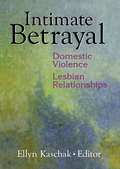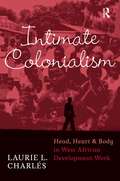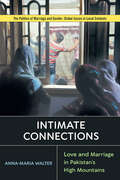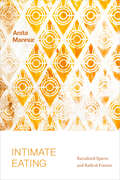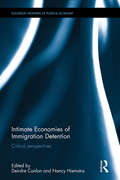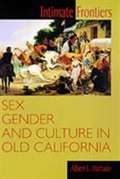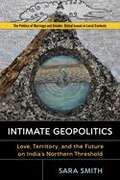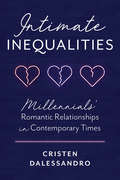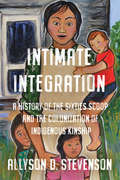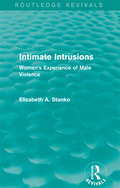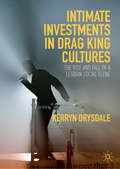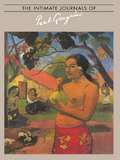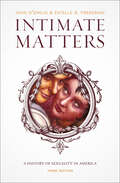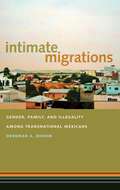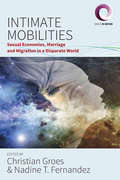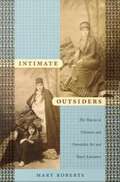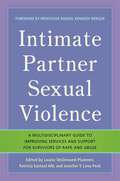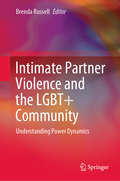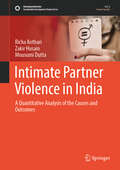- Table View
- List View
Intimate Betrayal: Domestic Violence in Lesbian Relationships
by Ellyn KaschakHelp ease the secret suffering of lesbians in abusive relationships!Why is woman-on-woman violence so often ignored or discounted? Intimate Betrayal: Domestic Violence in Lesbian Relationships uncovers the hidden problem of lesbians who hurt the women they love. This long-needed book brings together theory, practice, and research to suggest new and fruitful ways to understand, prevent, and treat this common problem. Intimate Betrayal provides new empirical research into the psychological and sociocultural causes of abuse. As several of the chapter authors demonstrate, neither traditional feminist theories about power nor heterosexist paradigms explain the causes, dynamics, or treatment of this problem. However, the new research presented here suggests helpful diagnostic criteria and effective treatments. Intimate Betrayal analyzes the factors that contribute to lesbian domestic violence, including: heterosexism and homophobia minority stress emotional isolation and lack of community ties revictimization of women who have previously suffered abuseThe thorough literature review included reveals the paucity of attention that has been paid to this problem. Intimate Betrayal suggests exciting new models for freeing women from domestic violence, including the use of clinical and community resources and liberation theology. Community activists, counselors, and psychologists will be intrigued by the insightful analysis of the root causes of lesbian-on-lesbian violence and the valuable treatment suggestions. Researchers will welcome the new avenues it opens for additional research.
Intimate Bonds: Family and Slavery in the French Atlantic (The Early Modern Americas)
by Jennifer L. PalmerFollowing the stories of families who built their lives and fortunes across the Atlantic Ocean, Intimate Bonds explores how households anchored the French empire and shaped the meanings of race, slavery, and gender in the early modern period. As race-based slavery became entrenched in French laws, all household members in the French Atlantic world —regardless of their status, gender, or race—negotiated increasingly stratified legal understandings of race and gender.Through her focus on household relationships, Jennifer L. Palmer reveals how intimacy not only led to the seemingly immutable hierarchies of the plantation system but also caused these hierarchies to collapse even before the age of Atlantic revolutions. Placing families at the center of the French Atlantic world, Palmer uses the concept of intimacy to illustrate how race, gender, and the law intersected to form a new worldview. Through analysis of personal, mercantile, and legal relationships, Intimate Bonds demonstrates that even in an era of intensifying racial stratification, slave owners and slaves, whites and people of color, men and women all adapted creatively to growing barriers, thus challenging the emerging paradigm of the nuclear family. This engagingly written history reveals that personal choices and family strategies shaped larger cultural and legal shifts in the meanings of race, slavery, family, patriarchy, and colonialism itself.
Intimate Citizenships: Gender, Sexualities, Politics (Routledge Research in Gender and Society)
by Elzbieta H. OleksyThis volume responds to the need to extend the theory of citizenship, in order to bridge the gap between the public and the private sphere. Through the application of intersectional methodology, the authors document how people’s most private decisions and practices are intertwined with public institutions and state policies. The stories of intimate citizenship included in this volume make the theoretical discussion more palpable. Situated perspectives, as well as application of theoretical concepts to lived experience, extend citizenship’s territory beyond the conventional public sphere and locate it at the intersection of many axes of social, political, and cultural stratification.
Intimate Colonialism: Head, Heart, and Body in West African Development Work (Writing Lives: Ethnographic Narratives)
by Laurie L CharlésLaurie Charlés finished her Ph.D., then took off to West Africa as a Peace Corps volunteer. Asked to create programs to help adolescent girls stay in school, she found herself enmeshed in the politics and cultural barriers that prevent these girls from creating a better life. But that was not all that was enmeshed. Charlés found love, sexual fulfillment, sexual harassment, and gender discrimination, all of which further complexified her stated mission. Her candid assessment of life and work in Africa, the intimate relationships that gave hope to the possibility of change, the emotional and physical highs and lows that affected her ability to function, all become factors affecting her success in improving the lives of African girls. This eloquent narrative should be of interest both to those doing development work and to those interested in autoethnographic exploration of the self.
Intimate Connections: Love and Marriage in Pakistan’s High Mountains (Politics of Marriage and Gender: Global Issues in Local Contexts)
by Anna-Maria WalterIntimate Connections dissects ideas, feelings, and practices around love, marriage, and respectability in the remote high mountains of Gilgit-Baltistan in northern Pakistan. It offers insightful perspectives from the emotional lives of Shia women and their active engagement with their husbands. These gender relations are shaped by countless factors, including embodied values of modesty and honor, vernacular fairy tales and Bollywood movies, Islamic revivalism and development initiatives. In particular, the advent of media and communication technologies has left a mark on (pre)marital relations in both South Asia and the wider Muslim world. Juxtaposing different understandings of ‘love’ reveals rich and manifold worlds of courtship, elopements, family dynamics, and more or less affectionate matches that are nowadays often initiated through SMS. Deep ethnographic accounts trace the relationships between young couples to show how Muslim women in a globalized world dynamically frame and negotiate circumstances in their lives.
Intimate Eating: Racialized Spaces and Radical Futures
by Anita MannurIn Intimate Eating Anita Mannur examines how notions of the culinary can create new forms of kinship, intimacy, and social and political belonging. Drawing on critical ethnic studies and queer studies, Mannur traces the ways in which people of color, queer people, and other marginalized subjects create and sustain this belonging through the formation of “intimate eating publics.” These spaces—whether established in online communities or through eating along in a restaurant—blur the line between public and private. In analyses of Julie Powell’s Julie and Julia, Nani Power’s Ginger and Ganesh, Ritesh Batra’s film The Lunchbox, Michael Rakowitz’s performance art installation Enemy Kitchen, and The Great British Bake Off, Mannur focuses on how racialized South Asian and Arab brown bodies become visible in various intimate eating publics. In this way, the culinary becomes central to discourses of race and other social categories of difference. By illuminating how cooking, eating, and distributing food shapes and sustains social worlds, Mannur reconfigures how we think about networks of intimacy beyond the family, heteronormativity, and nation.
Intimate Economies of Immigration Detention: Critical perspectives (Routledge Frontiers of Political Economy)
by Deirdre Conlon Nancy HiemstraInternational migration has been described as one of the defining issues of the twenty-first century. While a lot is known about the complex nature of migratory flows, surprisingly little attention has been given to one of the most prominent responses by governments to human mobility: the practice of immigration detention. Intimate Economies of Immigration Detention provides a timely intervention, offering much needed scrutiny of the ideologies, policies and practices that enable the troubling, unparalleled and seemingly unbridled growth of immigration detention around the world. An international collection of scholars provide crucial new insights into immigration detention recounting at close range how detention’s effects ricochet from personal and everyday experiences to broader political-economic, social and cultural spheres. Contributors draw on original research in the US, Australia, Europe, and beyond to scrutinise the increasingly tangled relations associated with detention operation and migration management. With new theoretical and empirical perspectives on detention, the chapters collectively present a toolbox for better understanding the forces behind and broader implications of the seemingly uncontested rise of immigration detention. This book is of great interest to those who study political economy, economic geography and immigration policy, as well as policy makers interested in immigration.
Intimate Enemies: Landowners, Power, and Violence in Chiapas
by Aaron Bobrow-StrainIntimate Enemies is the first book to explore conflicts in Chiapas from the perspective of the landed elites, crucial but almost entirely unexamined actors in the state's violent history. Scholarly discussion of agrarian politics has typically cast landed elites as "bad guys" with predetermined interests and obvious motives. Aaron Bobrow-Strain takes the landowners of Chiapas seriously, asking why coffee planters and cattle ranchers with a long and storied history of violent responses to agrarian conflict reacted to land invasions triggered by the Zapatista Rebellion of 1994 with quiescence and resignation rather than thugs and guns. In the process, he offers a unique ethnographic and historical glimpse into conflicts that have been understood almost exclusively through studies of indigenous people and movements. Weaving together ethnography, archival research, and cultural history, Bobrow-Strain argues that prior to the upheavals of 1994 landowners were already squeezed between increasingly organized indigenous activism and declining political and economic support from the Mexican state. He demonstrates that indigenous mobilizations that began in 1994 challenged not just the economy of estate agriculture but also landowners' understandings of progress, masculinity, ethnicity, and indigenous docility. By scrutinizing the elites' responses to land invasions in relation to the cultural politics of race, class, and gender, Bobrow-Strain provides timely insights into policy debates surrounding the recent global resurgence of peasant land reform movements. At the same time, he rethinks key theoretical frameworks that have long guided the study of agrarian politics by engaging political economy and critical human geography's insights into the production of space. Describing how a carefully defended world of racial privilege, political dominance, and landed monopoly came unglued, Intimate Enemies is a remarkable account of how power works in the countryside.
Intimate Enemies: Violence and Reconciliation in Peru (Pennsylvania Studies in Human Rights)
by Kimberly TheidonIn the aftermath of a civil war, former enemies are left living side by side—and often the enemy is a son-in-law, a godfather, an old schoolmate, or the community that lies just across the valley. Though the internal conflict in Peru at the end of the twentieth century was incited and organized by insurgent Senderistas, the violence and destruction were carried out not only by Peruvian armed forces but also by civilians. In the wake of war, any given Peruvian community may consist of ex-Senderistas, current sympathizers, widows, orphans, army veterans—a volatile social landscape. These survivors, though fully aware of the potential danger posed by their neighbors, must nonetheless endeavor to live and labor alongside their intimate enemies.Drawing on years of research with communities in the highlands of Ayacucho, Kimberly Theidon explores how Peruvians are rebuilding both individual lives and collective existence following twenty years of armed conflict. Intimate Enemies recounts the stories and dialogues of Peruvian peasants and Theidon's own experiences to encompass the broad and varied range of conciliatory practices: customary law before and after the war, the practice of arrepentimiento (publicly confessing one's actions and requesting pardon from one's peers), a differentiation between forgiveness and reconciliation, and the importance of storytelling to make sense of the past and recreate moral order. The micropolitics of reconciliation in these communities present an example of postwar coexistence that deeply complicates the way we understand transitional justice, moral sensibilities, and social life in the aftermath of war. Any effort to understand postconflict reconstruction must be attuned to devastation as well as to human tenacity for life.
Intimate Ephemera: Reading Young Lives in Australian Zine Culture
by Anna PolettiIntimate Ephemera is the first major study of autobiographical writing produced and consumed in a youth subculture. Investigating the uses of the zine form for life writing, it examines the recurrent themes in texts circulating in Australian zine culture, including depression, consumerism, popular culture and political identity. Intimate Ephemera also examines zine culture as a unique community of life writing and reading, where handmade texts circulate in an economy of gifting and exchange utilising the postal system. The book analyses the material diversity of zines as handmade objects, examining the use of the photocopier and craft techniques in these limited edition publications, bringing a focus to the role of the text-object in communicating personal experience.
Intimate Frontiers: Sex, Gender, and Culture in Old California (Histories of the American Frontier)
by Albert L. Hurtado<p>This book reveals how powerful undercurrents of sex, gender, and culture helped shape the history of the American frontier from the 1760s to the 1850s. Looking at California under three flags--those of Spain, Mexico, and the United States--Hurtado resurrects daily life in the missions, at mining camps, on overland trails and sea journeys, and in San Francisco. In these settings Hurtado explores courtship, marriage, reproduction, and family life as a way to understand how men and women--whether Native American, Anglo American, Hispanic, Chinese, or of mixed blood--fit into or reshaped the roles and identities set by their race and gender. <p>Hurtado introduces two themes in delineating his intimate frontiers. One was a libertine California, and some of its delights were heartily described early in the 1850s: "[Gold] dust was plentier than pleasure, pleasure more enticing than virtue. Fortune was the horse, youth in the saddle, dissipation the track, and desire the spur." Not all the times were good or giddy, and in the tragedy of a teenage domestic who died in a botched abortion or a brutalized Indian woman we see the seamy underside of gender relations on the frontier. The other theme explored is the reaction of citizens who abhorred the loss of moral standards and sought to suppress excess. Their efforts included imposing all the stabilizing customs of whichever society dominated California--during the Hispanic period, arranged marriages and concern for family honor were the norm; among the Anglos, laws regulated prostitution, missionaries railed against vices, and "proper" women were brought in to help "civilize" the frontier.</p>
Intimate Geopolitics: Love, Territory, and the Future on India’s Northern Threshold (Politics of Marriage and Gender: Global Issues in Local Contexts)
by Sara SmithWinner of the 2021 Julian Minghi Distinguished Book Award from the American Association of Geographers 2021 Foreword Indies Finalist - Politics and Social Sciences Intimate Geopolitics begins with a love story set in the Himalayan region of Ladakh, in India’s Jammu and Kashmir State, but this is also a story about territory, and the ways that love, marriage, and young people are caught up in contemporary global processes. In Ladakh, children grow up to adopt a religious identity in part to be counted in the census, and to vote in elections. Religion, population, and voting blocs are implicitly tied to territorial sovereignty and marriage across religious boundaries becomes a geopolitical problem in an area that seeks to define insiders and outsiders in relation to borders and national identity. This book populates territory, a conventionally abstract rendering of space, with the stories of those who live through territorial struggle at marriage and birth ceremonies, in the kitchen and in the bazaar, in heartbreak and in joy. Intimate Geopolitics argues for the incorporation of the role of time–temporality–into our understanding of territory.
Intimate Inequalities: Millennials' Romantic Relationships in Contemporary Times
by Cristen DalessandroWhen it comes to the topic of romantic and sexual intimacy, social observers are often quick to throw criticisms at millennials. However, we know little about millennials’ own hopes, fears, struggles, and triumphs in their relationships from the perspectives of millennials themselves. Intimate Inequalities uses millennials’ own stories to explore how they navigate gender, race, social class, sexuality, and age identities and expectations in their relationships. Situating millennials’ lives within contemporary social and cultural conditions in the United States, Intimate Inequalities takes an intersectional approach to examining how millennials challenge—or rather, uphold—social inequalities in their lives as they come into their own as full adults. Intimate Inequalities provides an in-depth look into the intimate lives of one group of millennials living in the United States, demystifying what actually goes on behind closed doors, and arguing that millennials’ private lives can reveal much about their ability to navigate inequalities in their lives more broadly.
Intimate Integration: A History of the Sixties Scoop and the Colonization of Indigenous Kinship (Studies in Gender and History)
by Allyson StevensonPrivileging Indigenous voices and experiences, Intimate Integration documents the rise and fall of North American transracial adoption projects, including the Adopt Indian and Métis Project and the Indian Adoption Project. Allyson D. Stevenson argues that the integration of adopted Indian and Métis children mirrored the new direction in post-war Indian policy and welfare services. She illustrates how the removal of Indigenous children from their families and communities took on increasing political and social urgency, contributing to what we now call the "Sixties Scoop." Making profound contributions to the history of settler colonialism in Canada, Intimate Integration sheds light on the complex reasons behind persistent social inequalities in child welfare.
Intimate Intrusions: Women's Experience of Male Violence (Routledge Revivals)
by Elizabeth StankoFirst published in 1985, this book looks at the victimisation of women, focusing on the four main areas of incest, rape, physical violence, and sexual harassment. Elizabeth Stanko’s work is based on original research and interviews with police forces, victims and others involved. It examines women’s experiences of male violence and looks at the reactions of those to whom women complain, including police officers, judges and union officials. The book analyses the decision making process of the criminal justice system and of administrative personnel at the time of publication, and Stanko shows how such institutions can be carriers of a male point of view.
Intimate Investments in Drag King Cultures: The Rise and Fall of a Lesbian Social Scene
by Kerryn DrysdaleThis book takes the globally recognised phenomenon of drag king performances as an opportunity for critical inquiry into the rise and fall of an urban scene for lesbian and queer women in Sydney, Australia (circa 1999-2012). Exploring how a series of weekly events provided the site for intimate encounters, Drysdale reveals the investments made by participants that worked to sustain the sense of a small world and anchor the expansive imaginary of lesbian cultural life. But what happens when scenes fade, as they invariably do? Intimate Investments in Drag King Cultures is unique in capturing the perspective of a scene at the moment of its decline, revealing the process by which a contemporary movement becomes layered with historical significance. Bringing together the theoretical tradition of scene studies with recent work on the affective potentialities of the everyday and the mobile urban spaces they inhabit, this book has appeal to scholars working across gender, sexuality and culture.
Intimate Journals Of Paul Gaugui
by GauguinThe Intimate Journals of Paul Gaugui, depicts the experiences of the French artist while living on a Polynesian island and discusses the culture of the natives of the island.
Intimate Matters: A History of Sexuality in America
by John D'Emilio Estelle B. Freedman“Fascinating . . . chart[s] a gradual but decisive shift in the way Americans have understood sex and its meaning in their lives.” —New York Times Book ReviewThe first full length study of the history of sexuality in America, Intimate Matters offers trenchant insights into the sexual behavior of Americans, from colonial times to today. D’Emilio and Freedman give us a deeper understanding of how sexuality has dramatically influenced politics and culture throughout our history.“Intimate Matters was cited by Supreme Court Justice Anthony Kennedy when, writing for a majority of court on July 26, he and his colleagues struck down a Texas law criminalizing sodomy. The decision was widely hailed as a victory for gay rights. . . . The justice mentioned Intimate Matters specifically in the court’s decision.” —Chicago Tribune“With comprehensiveness and care . . . D’Emilio and Freedman have surveyed the sexual patterns for an entire nation across four centuries.” —Nation“Comprehensive, meticulous and intelligent.” —Washington Post Book World“This book is remarkable . . . [Intimate Matters] is bound to become the definitive survey of American sexual history for years to come.” —Roy Porter, Journal of the History of the Behavioral Sciences
Intimate Migrations: Gender, Family, and Illegality among Transnational Mexicans
by Deborah A. BoehmIn her research with transnational Mexicans, Deborah A. Boehm has often asked individuals: if there were no barriers to your movement between Mexico and the United States, where would you choose to live? Almost always, they desire the freedom to “come and go.” Yet the barriers preventing such movement are many. Because of the United States’ rigid immigration policies, Mexican immigrants often find themselves living long distances from family members and unable to easily cross the U.S.-Mexico border. Transnational Mexicans experience what Boehm calls “intimate migrations,” flows that both shape and are structured by gendered and familial actions and interactions, but are always defined by the presence of the U.S. state. Intimate Migrations is based on over a decade of ethnographic research, focusing on Mexican immigrants with ties to a small, rural community in the Mexican state of San Luis Potosí and several states in the U.S. West. By showing how intimate relations direct migration, and by looking at kin and gender relationships through the lens of illegality, Boehm sheds new light on the study of gender and kinship, as well as understandings of the state and transnational migration.
Intimate Mobilities: Sexual Economies, Marriage and Migration in a Disparate World (Worlds in Motion #3)
by Christian Groes Nadine T. FernandezAs globalization and transnational encounters intensify, people’s mobility is increasingly conditioned by intimacy, ranging from love, desire, and sexual liaisons to broader family, kinship, and conjugal matters. This book explores the entanglement of mobility and intimacy in various configurations throughout the world. It argues that rather than being distinct and unrelated phenomena, intimacy-related mobilities constitute variations of cross-border movements shaped by and deeply entwined with issues of gender, kinship, race, and sexuality, as well as local and global powers and border restrictions in a disparate world.
Intimate Outsiders: The Harem in Ottoman and Orientalist Art and Travel Literature
by Mary RobertsUntil now, the notion of a cross-cultural dialogue has not figured in the analysis of harem paintings, largely because the Western fantasy of the harem has been seen as the archetype for Western appropriation of the Orient. In Intimate Outsiders, the art historian Mary Roberts brings to light a body of harem imagery that was created through a dynamic process of cultural exchange. Roberts focuses on images produced by nineteenth-century European artists and writers who were granted access to harems in the urban centers of Istanbul and Cairo. As invited guests, these Europeans were "intimate outsiders" within the women's quarters of elite Ottoman households. At the same time, elite Ottoman women were offered intimate access to European culture through their contact with these foreign travelers. Roberts draws on a range of sources, including paintings, photographs, and travelogues discovered in archives in Britain, Turkey, Egypt, and Denmark. She rethinks the influential harem works of the realist painter John Frederick Lewis, a British artist living in Cairo during the 1840s, whose works were granted an authoritative status by his British public despite the actual limits of his insider knowledge. Unlike Lewis, British women were able to visit Ottoman harems, and from the mid-nineteenth century on they did so in droves. Writing about their experiences in published travelogues, they undermined the idea that harems were the subject only of male fantasies. The elite Ottoman women who orchestrated these visits often challenged their guests' misapprehensions about harem life, and a number of them exercised power as patrons, commissioning portraits from European artists. Their roles as art patrons defy the Western idea of the harem woman as passive odalisque.
Intimate Partner Femicide: Contesting the Legal Story (Routledge Research in Gender and Society)
by Susan Goodwin Bethany WilkinsonDomestic violence legislation is a key response to the entrenched social problem of intimate partner violence across the globe, yet little is known about the legal players who implement these laws in terms of their perceptions of intimate partner violence and femicide. Through in-depth, critical analysis of judicial transcripts, this book demonstrates that legal understandings of intimate partner femicide continue to be based upon outdated notions of 'couple conflict' and gender-neutral constructions of intimate partner violence. Contending that judicial understandings of ‘what happened’ must be re-aligned with feminist understandings of intimate partner violence and femicide, Intimate Partner Femicide: Contesting the Legal Story ... represents a call to uphold the rights of women to live free from male-perpetrated violence and femicide. This book will therefore appeal to scholars across the social sciences with interests in gendered violence, law, social justice and criminology.
Intimate Partner Sexual Violence: A Multidisciplinary Guide to Improving Services and Support for Survivors of Rape and Abuse
by Janice L. Ristock Mike Davis Walter S. Dekeseredy Patricia Easteal Debbie Kilroy Jacquelyn C. Campbell Jessica E. Draughon Vanita Parekh Lynn Hecht Schafran Charlotte Palmer Jocelyn Anderson S. Caroline Taylor Isabel Morgan Claire Zara Angela Williams Isabelle Kerr Jennifer Y. Levy-Peck Marianne Winters Susan Elizabeth Reid Raquel Kennedy Bergen Elizabeth Anne Layton Barbara Roberts Diane Macleod Emma Williamson Debra F. Parkinson Louise Mcormond Plummer Bushra Sabri Veronica Barcelona MendozaIntimate Partner Sexual Violence (IPSV) is the most common type of sexual violence and a common component of domestic violence, yet most cases go unreported and service responses are often inadequate. This book brings together advice for all those professionals working with individuals who have experienced IPSV and puts forward recommendations to tackle this prevalent form of sexual violence. With contributions from leading experts on IPSV, Intimate Partner Sexual Violence is a comprehensive guide to the subject which bridges the gap between research and practice. Multidisciplinary and international in approach, the book covers key issues salient to all professionals - the impact of IPSV, reproductive coercion, the physical and psychological indicators, possible consequences of taking a case to court, and best practice service responses. One section also addresses the risks and needs of IPSV victims in different contexts, such as those in same-sex or teenage relationships, immigrant victims, and those living in rural areas or in prison. This is an authoritative resource for all professionals who work with IPSV victims including counselors, social workers, refuge workers, victim advocates, mental health professionals, pastoral workers, lawyers, police, and health practitioners.
Intimate Partner Violence and the LGBT+ Community: Understanding Power Dynamics
by Brenda RussellIntimate Partner Violence is a serious social problem affecting millions in the United States and worldwide. The image of violence enacted by a male aggressor to a female victim dominates public perceptions of intimate partner violence (IPV). This volume examines how this heteronormativity influences reporting and responding to partner violence when those involved do not fit the stereotype of a typical victim of IPV. Research and theory have helped us to understand power dynamics about heterosexual IPV; this book encourages greater attention to the unique issues and power dynamics of IPV in sexual minority populations. Divided into five distinct sections, chapters address research and theories associated with IPV, examining the similarities and differences of IPV within heterosexual and gender minority relationships. Among the topics discussed:Research methodology and scope of the problemPrimary prevention and intervention of IPV among sexual and gender minoritiesBarriers to help-seeking among various populationsPromoting outreach and advocacyCriminal justice response to IPV With recommendations for intervention and prevention, criminal justice response and policy, Intimate Partner Violence and the LGBT+ Community: Understanding Power Dynamics will be of use to students, researchers, and practitioners of psychology, criminal justice, and public policy.
Intimate Partner Violence in India: A Quantitative Analysis of the Causes and Outcomes (Sustainable Development Goals Series)
by Zakir Husain Mousumi Dutta Richa KothariThis volume comprehensively analyzes the determinants and consequences of intimate partner violence in India. It examines the contested relationship between empowerment and intimate partner violence—at individual and community levels. It highlights the short and long-term effects of intimate partner violence on the children of victims. The book employs up-to-date quantitative methods and is based on a recently released nationally representative database. The focus is on India, a fast-growing South Asian country with poor gender indicators. It extends the understanding of intimate partner violence to developing countries lacking poor victim support bases. It also addresses SDG5, “eliminate all forms of violence against all women and girls in the public and private spheres, including trafficking and sexual and other types of exploitation.” The book is essential for anyone interested in the data-based analysis of intimate partner violence and activists and policymakers seeking to reduce such violence in India.
